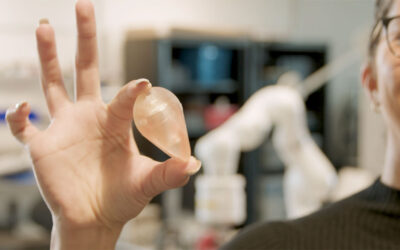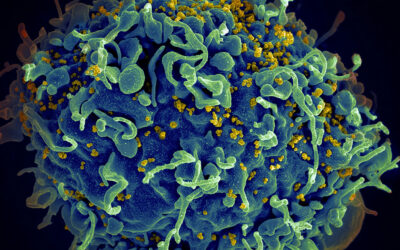Engineers at Northwestern University have developed a pacemaker small enough to fit inside the tip of a syringe. This allows doctors to inject it into the body without surgery.
The pacemaker is specifically designed for patients who need temporary heart pacing. All of its components are made of biocompatible materials that dissolve after the device has done its job.
“Our major motivation was children,” said Igor Efimov, professor of biomedical engineering and cardiology at Northwestern University. “About 1% of children are born with congenital heart defects — these children only need temporary pacing after a surgery. In about seven days or so, most patients’ hearts will self-repair, but those seven days are absolutely critical.”
The miniature pacemaker is controlled with a wireless wearable device that is placed on the chest and monitors the heartbeat. When the device detects an irregular heartbeat, it shines short pulses of infrared light that travel through skin, bone and muscle to turn the pacemaker on and off, restoring a normal heart rate.
Despite being just a few millimetres thick, the pacemaker has shown to be as powerful as its full-sized version.
“We have developed what is, to our knowledge, the world’s smallest pacemaker,” said John Rogers, professor of materials science and engineering at Northwestern University, who led the development of the device. “There’s a crucial need for temporary pacemakers in the context of pediatric heart surgeries, and that’s a use case where size miniaturization is incredibly important.”
The making of a miniature pacemaker
Temporary pacemakers used today typically require sewing electrodes directly onto the heart. While uncommon, implanting and removing these electrodes carries a risk of complications such as infections or internal bleeding. Efimov explained this can happen when the body grows scar tissue around the wires, damaging the heart when they are pulled out.
As part of a previous study, Efimov and Rogers had developed a larger version of the dissolvable pacemaker, intended for patients who require a temporary pacing solution — for instance, to help stabilize the heart after surgery.
The original pacemaker was the size of a quarter and successfully eliminated the need for bulky batteries and wires. But while the device performed well in animal studies, heart surgeons asked the researchers if it would be possible to make it even smaller.
This posed a challenge. Their first pacemaker was controlled using radio frequencies and powered by near-field communication — the same technology smartphones use for electronic payments — which require an antenna to work.
“Our original pacemaker worked well,” said Rogers. “But the size of its receiver antenna limited our ability to miniaturize it.”
The solution involved replacing the radio system with a light switch triggered by infrared light, which can travel safely through the body. The engineers also developed a miniature battery consisting of two different metals. On contact with bodily fluids, the metals start a chemical reaction that produces enough energy to power the tiny pacemaker.
“When the pacemaker is implanted into the body, the surrounding fluids act as the conducting electrolyte that electrically joins those two metal pads to form the battery,” Rogers explained. “A very tiny light-activated switch on the opposite side from the battery allows us to turn the device from its ‘off’ state to an ‘on’ state.”
Despite the minute size of the battery, it provides enough energy to power the pacemaker for the duration of its entire lifespan.
“The heart requires a tiny amount of electrical stimulation,” Rogers said. “By minimizing the size, we dramatically simplify the implantation procedures, we reduce trauma and risk to the patient, and we eliminate any need for secondary surgical extraction procedures.”
The researchers tested their miniature pacemaker in a variety of animals as well as in donor hearts, with successful results. Rogers estimates that the device could enter clinical trials within two to three years.
The technology behind this pacemaker could have applications beyond cardiology, including electrotherapy to heal nerves, bones and wounds, as well as for pain management. The composition and the thickness of the materials used to make biodegradable electronics can be altered to control the number of days they remain functional before dissolving — enabling the scientists to tailor it to diverse applications.
Going forward, the scientists are interested in the possibility of placing multiple of the tiny pacemakers across the heart to enable more precise control of the pacing of the different areas of the heart. This approach could for instance treat irregular heartbeats, also known as arrhythmias.
Rogers added that another avenue of research will involve incorporating the pacemakers into other medical devices, such as heart valve replacements.
“Because it’s so small, this pacemaker can be integrated with almost any kind of implantable device,” he said. “Here, the tiny pacemakers can be activated as necessary to address complications that can occur during a patient’s recovery process. That’s just one example of how we can enhance traditional implants.”
Reference: Yamin Zhang et al., Millimetre-scale bioresorbable optoelectronic systems for electrotherapy, Nature (2025). DOI: 10.1038/s41586-025-08726-4
Feature image credit: mirkosajkov on Pixabay

















